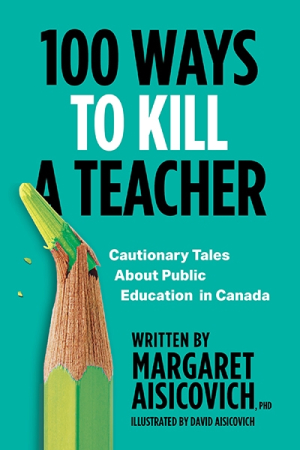100 Ways to Kill a Teacher
Cautionary Tales about Public Education in Canada
100 Ways to Kill a Teacher is a knowledgeable educators’ guide that exposes problems in Canadian public education and suggests workable solutions.
Educator Margaret Aisicovich’s social science text 100 Ways to Kill a Teacher concerns the systemic shortcomings of public education in Canada.
“It is time to have the conversation openly and to address systemic shortcomings in public education in Canada,” says Aisicovich. Written from a teacher’s viewpoint and for fellow educators, her book is an experience-based guide to surviving in school environments. Aisicovich exposes dysfunction in the educational system on multiple levels and comments on its impact on administrators, teachers, students, and parents. She also covers topics as varied as getting hired, recognizing who’s who in the school hierarchy, and handling toxic positivity, which the book says prevents those in power from dealing with problems as they arrive.
The text also includes warnings about on-the-job sexual harassment, racism directed at vulnerable students and non-white teachers, and the dangers of taking a stand for change. It uses real-life stories to support its various claims, as when it follows teachers who made an effort to earn advanced degrees and were replaced by new, inexperienced teachers as a cost-cutting measure. This perspective on the educational system suggests that it is antiquated, and that it fosters, rather than counteracts, economic and social inequity.
This is a text that remains aware throughout of how the practice of teaching differs from optimistic prospective teachers’ expectations. Its stories of the day-to-day experiences of teachers convey frustration, but also lead into its calls to action. Indeed, the book has systemic reform in mind, and beyond its bleak revelations and forecasts are encouraging stories about good educators who help their students to thrive. Practical recommendations for improvement, including that teachers be treated as full partners, and for the implementation of systems for autodidactic learning, are forwarded, and this work is supported with articles from respected newspapers.
As the text alternates between arguments for reform and stories from the field, its tone varies from containing wry humor to righteous anger. Catchy chapter and section titles support its inviting investigations into, and recommendations for confronting, school hierarchies; they are complemented by humorous illustrations that relieve the stress-inducing nature of the issues it exposes, including around injustices, racism, and economic inequity, all of which take a harsh toll on students.
100 Ways to Kill a Teacher is an educators’ guide that exposes problems in Canadian public education and suggests means of improvement.
Reviewed by
Kristine Morris
Disclosure: This article is not an endorsement, but a review. The publisher of this book provided free copies of the book and paid a small fee to have their book reviewed by a professional reviewer. Foreword Reviews and Clarion Reviews make no guarantee that the publisher will receive a positive review. Foreword Magazine, Inc. is disclosing this in accordance with the Federal Trade Commission’s 16 CFR, Part 255.

